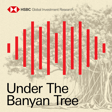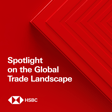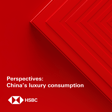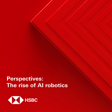Become a Creator today!Start creating today - Share your story with the world!
Start for free
00:00:00
00:00:01

HSBC Emerging Markets Spotlight Podcast Series - Nearshoring to Mexico: It’s happening already, what’s next?
Nearshoring is a growing trend in Mexico. In this episode, we explore what nearshoring is. We look at why it is happening in Mexico, and what makes Mexico such and attractive place for the phenomenon. Finally, we explore trends companies should be aware.
Emerging Markets Spotlight is a podcast miniseries created and hosted by HSBC that seeks to explore and understand the complex and critically important issues facing the world’s emerging markets. For further insight and information around emerging markets, visit Accessing Emerging Markets | HSBC
Hosted on Acast. See acast.com/privacy for more information.
Transcript
Introduction to HSBC Global Viewpoint
00:00:02
Speaker
Welcome to HSBC Global Viewpoint, the podcast series that brings together business leaders and industry experts to explore the latest global insights, trends, and opportunities.
00:00:13
Speaker
Make sure you're subscribed to stay up to date with new episodes.
00:00:16
Speaker
Thanks for listening, and now onto today's show.
Emerging Market Spotlight Overview
00:00:32
Speaker
Welcome to the Emerging Market Spotlight, a podcast series from HSBC.
00:00:38
Speaker
The emerging markets landscape is more complex than ever at a time of divergent monetary policy, high commodity prices, supply chain disruptions, and geopolitical tensions.
00:00:52
Speaker
Join us as we speak with world's leading institutional investors, experts, policymakers, and thought leaders to explore the challenges and opportunities.
00:01:03
Speaker
Make sure you subscribe to HSBC Global Viewpoint and stay up to date with new episodes.
00:01:10
Speaker
Thanks for listening.
00:01:11
Speaker
And now on to today's show.
Nearshoring to Mexico: Trends and Drivers
00:01:17
Speaker
Hi, good morning, good afternoon, everyone.
00:01:19
Speaker
Thank you so much for joining us.
00:01:21
Speaker
We are going to discuss about this phenomenon of nearshoring to Mexico, which has become a key trend and a key theme for the Mexican Economic Outlook.
00:01:31
Speaker
I will be joined by two persons that are very close to the theme and that can share with us
00:01:37
Speaker
a lot of color on what has been happening over the last few months about this theme and especially on what can we expect going forward and the relevant themes behind this.
00:01:48
Speaker
Firstly, we have Eduardo Ramos, who is a Senior Consultant in Public Policy and Affairs and International Trade at De La Calle Madrazo Mancera.
00:01:59
Speaker
And we are also joined by our HSBC Mexico CEO, Jorge Arce.
00:02:05
Speaker
So, Eduardo, Jorge, thank you so much for being with us today.
00:02:09
Speaker
Thank you.
00:02:10
Speaker
Thank you, everyone.
00:02:11
Speaker
It's a privilege to be sharing this with you.
00:02:14
Speaker
Let me start by saying something about reassuring.
00:02:21
Speaker
And it is very clear that there were certain structural conditions and some political events and emergency situations that favor reassuring in Mexico.
00:02:33
Speaker
And that's very clear.
00:02:35
Speaker
The structural one, and this would be very obvious for everyone, it's the technological changes that basically allow
00:02:43
Speaker
the firms to reduce the segments of the global value chains.
00:02:46
Speaker
And certainly that's a key issue problem that allows nearshoring, not only in Mexico, but in other places.
00:02:54
Speaker
But also it is very clear that the US-China trade and technological war was another important element that foster nearshoring in terms of the necessity to have reliance on the value chains.
Clarifying Nearshoring: Misconceptions and Realities
00:03:09
Speaker
Lastly, but not less important, the political regional initiatives.
00:03:14
Speaker
Of course, one of the most important ones in Mexico relates to the USMCA.
00:03:23
Speaker
However, I have to say the following.
00:03:25
Speaker
We're talking about nearshoring, but let me say what it is not.
00:03:29
Speaker
does not mean the relocation of all the investments from one region or country to another, say Asia or China into Mexico or North America.
00:03:39
Speaker
That's not nearshoring.
00:03:41
Speaker
And nearshoring neither is the relocation of complete value chains from one place to another.
00:03:52
Speaker
Normally, this relocation takes place in segments.
00:03:56
Speaker
That is, segments of the value chains are going to move from one place to another where these countries where they are relocating are competitive.
00:04:05
Speaker
Otherwise, they wouldn't be moving.
00:04:07
Speaker
So this is kind of important because otherwise we can have the sense that the whole value chains are going to move completely with all their segments from one place to another, and that's not the case.
Opportunities and Challenges for Mexico
00:04:21
Speaker
We need to have into account also, and I assume at the bank you look at this every day, that nurturing could be costly and in some cases it's impractical to serve some other markets.
00:04:34
Speaker
We cannot move everything into Mexico or North America to serve, for example, Asian markets.
00:04:39
Speaker
That could not work.
00:04:41
Speaker
So that's important to say.
00:04:44
Speaker
And something that reflects this is that, for example, with China, when we say that relocation is taking place and things are moving from China into other places, it is true that in some cases this is not taking place.
00:04:57
Speaker
Some value chains or segments of the value chains remain in China, even
00:05:03
Speaker
with the tariffs that the US has imposed into China.
00:05:07
Speaker
So this would be an example that not all the value chains or their segments could be moving from one place to another.
00:05:13
Speaker
Certainly, Mexico has the right context to benefit from new shoring.
00:05:18
Speaker
And the economic context is a little bit challenging in the sense that the US economy is slowing down.
00:05:25
Speaker
The good news is that we won't have a recession, but we're going to have a soft landing.
00:05:29
Speaker
And basically this means because the high integration between Mexico and the US economy, what this means is it will be a little bit more difficult for Mexico to increase its participation in the US economy.
00:05:41
Speaker
But this is happening regardless of the fact that industrial activity in the US, regardless of the fact that US imports are slowing down.
00:05:51
Speaker
So then to finalize, ensuring I believe that it's an historic opportunity for Mexico, but certainly the country has challenges.
00:05:59
Speaker
There is evidence that this is happening, but the country would have to make things right in order to take advantage of the opportunity.
Mexico's Evolution as an Import-Export Powerhouse
00:06:06
Speaker
Thank you.
00:06:06
Speaker
Thank you so much, Eduardo.
00:06:07
Speaker
Very, very clear.
00:06:09
Speaker
So now, Jorge, any initial remark you would like to make?
00:06:13
Speaker
Thank you, Jose Carlos.
00:06:13
Speaker
Thank you, Eduardo.
00:06:14
Speaker
I agree with Eduardo's comments more.
00:06:17
Speaker
I think it's important also to put a context of where Mexico is, what is near shoring, and what is Mexico's economy look like.
00:06:26
Speaker
For the last 30 years, Mexico has turned itself around into an import-export country.
00:06:33
Speaker
in which you have the ability to export import inputs and produce inputs locally and export to the world thanks to over 40 something treaty agreements.
00:06:44
Speaker
The most important obviously the what we used to know as NAFTA now is just MCA with its updated version.
00:06:53
Speaker
And no country is more open than Mexico.
00:06:56
Speaker
So we created this ecosystem in logistics, factories, workers, that is geared to export to the world and to trade with the world.
00:07:08
Speaker
So nobody buys more from the U.S. than Mexico and nobody sells more to the U.S. than Mexico.
00:07:14
Speaker
But that is also the case with other trading partners throughout the world.
00:07:17
Speaker
So Mexico has turned itself during the last 30 years into this export powerhouse.
00:07:23
Speaker
Within this basis, we are more than able to benefit from reallocation of supply chains or production facilities that we call it now nearshoring, which are coming from other parts of the world that really never invested in Mexico in a substantial manner as they are doing now.
00:07:43
Speaker
What is happening is within this context, Mexico can capture that opportunity and we see that we are capturing it.
00:07:50
Speaker
So the opportunity here is not relocate
Indicators of Nearshoring Success
00:07:53
Speaker
supply chains, relocate operations, relocate factories from Asia, China into Mexico, but to work in coordination and have the opportunity to be more efficient to serve your markets and your clients.
00:08:05
Speaker
And that's the primary accelerator of investment in Mexico that we've seen this year, for example, that's
00:08:11
Speaker
This year, we're going to see probably an excess of $40 billion in foreign direct investment, which will be the record of records.
00:08:18
Speaker
That's clear evidence that Mexico is benefiting from this trend.
00:08:23
Speaker
And it's local companies already producing in Mexico, but also a new entrance producing in Mexico to sell to the world.
00:08:31
Speaker
Excellent, Jorge.
00:08:31
Speaker
Thank you.
00:08:32
Speaker
Eduardo, maybe if you can elaborate a bit, for example, on what kind of evidence would you be seeing in the last few months or what kind of evidence can we start to look more clearly in the next few months?
00:08:47
Speaker
Maybe we can kick off with that.
00:08:49
Speaker
Perfect, Mr. Carlos.
00:08:51
Speaker
Let me consider one variable, and I think it's accurate evidence that NeuroSharing is happening.
00:08:58
Speaker
And then I can mention some other ones in which we, and Jorge has mentioned some of them.
00:09:04
Speaker
And we can say that this new showing is happening clearly.
Nearshoring as a Central Business Strategy
00:09:08
Speaker
Let me take just as a reference the starting of the trade war between China and the US.
00:09:15
Speaker
And just take as a reference the participation that Mexico has in US market and also the participation that China has in US market.
00:09:24
Speaker
Certainly, this participation has fallen for China.
00:09:29
Speaker
And in those percentage points, this fall represents almost eight percentage points since between 2018 and 2023.
00:09:42
Speaker
Most of this fall took place between 2018 and 2022.
00:09:48
Speaker
The fall between these years, 2018 and 2022, was of almost 5 percentage points.
00:09:59
Speaker
That's the fall that China had in its participation in US imports.
00:10:03
Speaker
Now, in contrast, between 2018 and 2023,
00:10:10
Speaker
Mexico has increased its participation in US imports in almost two percentage points.
00:10:16
Speaker
Now, a way to measure, so to speak, this new shoring, and once again, this is just one indicator, is somehow how Mexico has
00:10:29
Speaker
taking advantage of this fall of China's participation in US imports and taking that participation.
00:10:37
Speaker
And maybe that's the main indicator that Nishon is happening in Mexico.
00:10:44
Speaker
Yeah, that's very clear, Eduardo.
00:10:47
Speaker
Thank you.
00:10:48
Speaker
And maybe now that you mention all of this and this evidence that is starting to be a bit more clear with some macro indicators, maybe, Jorge, we can move with you.
00:10:59
Speaker
You have been traveling the country in the last couple of years to meet many of our national customers, and you have also had conversations with global customers today.
00:11:10
Speaker
And it seems that the concept about nearshoring that was one year ago, two years ago, is very different to the one that we have now, right?
00:11:18
Speaker
In the sense that two years ago, it was kind of a nice story that if everything was going to be okay, probably it was opportunity.
00:11:27
Speaker
But now it seems that when you talk to either local or global customers, Nearsharing has become kind of a key part of the narrative, key part of their plans, of their operation plans for the next one, two, three, four years.
Beneficial Sectors and Mexico's Strategic Advantages
00:11:42
Speaker
So maybe it's a good opportunity to ask you, what's the sentiment you have perceived from these customers recently in the meetings that you have had?
00:11:51
Speaker
How do you think they are incorporating that?
00:11:53
Speaker
And any color you might give us to probably get some sentiment from customers?
00:12:02
Speaker
Okay.
00:12:02
Speaker
There are two phenomenons playing.
00:12:05
Speaker
The first one is that, and this is the easiest one that we're all aware of, is that Mexico is
00:12:11
Speaker
such an important, very important of
00:12:14
Speaker
US and Canada, that it has specialized its economy in certain sectors that has strong competitive advantages and that it's a world leader.
00:12:24
Speaker
Also, we have seen in Mexico the development of a complete new industry that never exported before, which is the agricultural sector.
00:12:33
Speaker
So in Mexico, we're seeing a lot of the production of berries coming into Mexico and obviously avocado, tomatoes.
00:12:41
Speaker
So Mexico is going to export
00:12:44
Speaker
in agricultural products this year, $77 billion.
00:12:47
Speaker
Okay, that makes them one of the top exporters of agricultural products in the world that never happened before.
00:12:54
Speaker
In the other side, on the near shore end, we're seeing companies, middle-sized companies that used to have or continue to have manufacturing production in China, in Southeast Asia, coming to Mexico to look for local contractual manufacturers.
00:13:11
Speaker
to put their own plans, to co-invest, because they want to produce kitchen utensils to sell to the typical retailers in the U.S. Different types of companies that are coming to Mexico to set up production, to sell an just-time inventory to retailers that they are looking for.
00:13:30
Speaker
So that...
00:13:31
Speaker
It's new, okay?
00:13:33
Speaker
And they come to Mexico and they say, well, we might not be able to source stainless steel of this quality in North America, but we can import it from China or from Germany.
00:13:42
Speaker
Well, Mexico can import that almost free of tariffs.
00:13:45
Speaker
But the end product probably is going to be made in Mexico to sell in Black Friday into the US, you know, just in time inventory basis.
00:13:54
Speaker
So we are seeing different players that we never saw before.
00:13:57
Speaker
And that's where the strength of foreign investment is coming.
00:14:00
Speaker
That's where we are seeing the growth in exports and different type of exports.
Challenges to Industrial Growth
00:14:05
Speaker
Excellent.
00:14:05
Speaker
I mean, talking about this sentiment, talking about this evidence, the next natural question would be, for example, given what you were mentioning about what is nearshoring and what is not, in this context, for example, of about having different phases of developments according to every specific sector that we have in Mexico,
00:14:26
Speaker
In your point of view, which are the sectors that probably can benefit the most or which are the sectors that probably have an edge over the rest of the sectors?
00:14:35
Speaker
Absolutely.
00:14:36
Speaker
And look, obviously we have the competitive advantage to produce cars and auto parts.
00:14:43
Speaker
We have met with a lot of CEOs from global companies from Asia, Europe and the U.S.,
00:14:51
Speaker
when they come to Mexico and they say that there is no better place to produce cars than in Mexico.
00:14:57
Speaker
Why?
00:14:58
Speaker
Because we have the ecosystem, we have done it for the last, well, in scale for the last 70 years, but to do our next sporting driven auto sector for the last 30.
00:15:12
Speaker
So critical mass, you develop a lot of expertise, you develop a workforce, a relationship with unions that are so important right now, you see what's happening in the US.
00:15:22
Speaker
So there is no better place to produce a car and most profitable.
00:15:26
Speaker
There are companies in the US that credit Mexico to have saved the companies for their production here after the crisis, the economic crisis.
00:15:33
Speaker
But we don't see in the headlines something that is happening every year that all the large producers of cars in the world are increasing their investment in Mexico and using Mexico to invest as a platform for global platforms.
00:15:47
Speaker
And that will continue.
00:15:48
Speaker
And that has developed local suppliers of parts.
00:15:52
Speaker
So we export much more parts than finished product.
00:15:57
Speaker
And that has developed those producers of parts
00:16:00
Speaker
auto parts also produce other things for other industries.
00:16:04
Speaker
So we are talking about the medical sector, medical devices, appliances.
00:16:11
Speaker
So we have developed this expertise in metal works, in certain appliances and auto parts that is
00:16:20
Speaker
the main driving force of manufactured exports.
00:16:23
Speaker
But also heavy industry is producing in Mexico.
00:16:28
Speaker
A lot of new companies that used to produce in Mexico, certain products are expanding their production.
00:16:33
Speaker
And that's when some of our Asian clients come to Mexico and says, I need this plastic.
00:16:40
Speaker
I need this supplier that can
00:16:44
Speaker
shape this aluminum piece in this way and I need these compressors, where can I find them?
00:16:51
Speaker
And they say, yeah, you can find them here and here and here.
00:16:54
Speaker
So right now we used to have clients that only produce pumps.
00:16:57
Speaker
Now we're producing end products like lawnmowers.
00:17:02
Speaker
So this sophistication is only happening in Mexico because it's openness, obviously the geographical closeness to the US, but also it's because it's so easy to invest in Mexico.
00:17:13
Speaker
No, you don't have exchange controls, the pesos free tradable, you can hedge, you can do many other things.
00:17:19
Speaker
There's plenty of financing, local and international to put something in Mexico.
00:17:24
Speaker
So that's an additional derivative that people don't see that has been created in the last 30 years.
Regional Economic Disparities in Mexico
00:17:31
Speaker
Excellent.
00:17:32
Speaker
Thank you, Jorge.
00:17:33
Speaker
As in every opportunity or big trend, such as the one that we are seeing with nearshoring, of course, there are also some challenges, some things that can be done a bit better in order to speed up some of the investment.
00:17:46
Speaker
There are some things that can be updated in order to try to be a bit more aligned with the dynamics that we are seeing now.
00:17:55
Speaker
So maybe we can start with you, Eduardo.
00:17:58
Speaker
I mean, from your point of view, what are
00:18:01
Speaker
these challenges that the Mexican economy has currently in order to improve the dynamic.
00:18:08
Speaker
If you can give us like the big picture and your main challenges from your point of view would be appreciated.
00:18:15
Speaker
There are very many, but basically maybe one of the most important ones relates to energy, availability of energy.
00:18:24
Speaker
And this is not energy just in general.
00:18:27
Speaker
We need sufficient, competitive and clean energy.
00:18:33
Speaker
It's obvious that we need sufficient energy, but we need clean energy because of all the commitments that countries and enterprises have in terms of producing with clean energy.
00:18:44
Speaker
And of course, as we have this process of electrification of the economy,
00:18:50
Speaker
This is going to be more the case in the future.
00:18:52
Speaker
So this is maybe one of the most important challenges that we have.
00:18:56
Speaker
Maybe the second one relates basically to human capital.
00:19:00
Speaker
We do have a lot of qualified workforce that even that real salaries have increased, we're still competitive in the world.
00:19:09
Speaker
But in any case, if we need to bring
00:19:14
Speaker
these segments of the value chains that are more technological intensive, we have a challenge to reskill and upskill our workforce.
00:19:26
Speaker
And so that's maybe the second challenge that I would mention.
00:19:31
Speaker
And the third one, we also have a challenge in terms of logistics and infrastructure.
00:19:37
Speaker
This includes industrial parks and it's amazing the demand that they are having in terms of space.
00:19:43
Speaker
The availability of parks is reducing, even though they're increasing capacity.
00:19:50
Speaker
So, and these rents are going up.
00:19:55
Speaker
So, we have a challenge there together with that of infrastructure, transportation infrastructure also.
00:20:02
Speaker
I would stop there.
00:20:03
Speaker
We have others, but I would say that these are the three most important ones.
00:20:07
Speaker
Excellent, excellent.
00:20:09
Speaker
Jorge, maybe we can go with you with a question that we have about regional performances, right?
00:20:16
Speaker
But I mean, if you can share a bit of your thoughts and color on...
00:20:21
Speaker
How do you see, for example, this regional performance?
00:20:23
Speaker
Because it seems that the focus is starting to shift towards some southern states.
00:20:29
Speaker
A couple of months ago, there were some fiscal incentives announced in order to try to develop this Isthmus-De Tehuantepec corridor that is
00:20:39
Speaker
pretending to connect the east and west of the country and work as an inter-oceanic corridor to be there.
00:20:47
Speaker
So would you say that only the northern states of the country are dominating this story?
00:20:53
Speaker
Because we have already heard some actual investment cases in some southern states.
00:20:59
Speaker
So, I mean, any thoughts, any insight you have on that at the regional level?
00:21:07
Speaker
Well, I think that's one of the biggest challenges that Mexico has faced for generations and generations is the how unequal development has been between center northern states and some of the coasts and southern Mexico.
00:21:22
Speaker
So Mexico is probably two or three countries in one.
00:21:27
Speaker
And this is one of the challenges that the country has.
00:21:30
Speaker
So what we see, obviously, is central Mexico.
00:21:33
Speaker
Mexico City, for example.
00:21:35
Speaker
Mexico City is a great story.
00:21:38
Speaker
We see an ecosystem of fintechs and technology companies and movie production companies.
00:21:45
Speaker
Even us, for example, we are doing near-shoring.
00:21:48
Speaker
We have moved.
00:21:49
Speaker
We have about
00:21:50
Speaker
2,500 jobs in Mexico City that service HSBC globally.
00:21:58
Speaker
And we not only do like low value added services, we do over 600 services that some of them are highly skilled data analytics and how we use that data to provide services to our clients.
00:22:12
Speaker
It's not just only transactional and
00:22:15
Speaker
and mechanical.
00:22:17
Speaker
It's real engineering, real things.
00:22:20
Speaker
So the central part of Mexico, which we call it the Bajillo, and even the Guadalajara region on the occidente, and that's a particular area that's doing really well also because agriculture is growing at rates that you cannot see even in the most dynamic areas of Asia.
00:22:39
Speaker
Okay?
00:22:41
Speaker
northern part of Mexico is saturated.
00:22:43
Speaker
Most people are moving further south for certain things.
00:22:49
Speaker
And those cities in central Mexico tend to be developed.
00:22:52
Speaker
Because when you go to Mexico, you not only want to have cheap labor, electricity, or logistics, you want to have
00:22:59
Speaker
your executives to live in a city that has a cultural life, schools, and those cities in the northern part of Mexico, the west, central Mexico, they are better here.
00:23:11
Speaker
But there is good incentives to go to southern Mexico.
00:23:17
Speaker
So we see that a lot of things are happening that are going to help develop the south, further develop the north, and change what we do as a country, depending on where you are located.
Conclusion and Podcast Subscription Reminder
00:23:29
Speaker
Thank you.
00:23:29
Speaker
Thank you, Jorge.
00:23:30
Speaker
Well, we are now out of time.
00:23:33
Speaker
I just want to thank you both for being with us.
00:23:35
Speaker
I think this was a very productive discussion.
00:23:38
Speaker
So for the moment, thanks so much to both of you and thank you everyone for joining us.
00:23:46
Speaker
Thank you for joining us for this episode of Emerging Market Spotlight.
00:23:51
Speaker
We hope you enjoy the discussion.
00:23:54
Speaker
HSBC is uniquely positioned to connect investors and corporates internationally.
00:24:00
Speaker
To learn more about anything you heard today, visit gbm.hsbc.com or contact your HSBC representative.
00:24:10
Speaker
Make sure you subscribe to HSBC Global Viewpoint and stay up to date with new episodes.
00:24:27
Speaker
Thank you for joining us at HSBC Global Viewpoint.
00:24:31
Speaker
We hope you enjoyed the discussion.
00:24:33
Speaker
Make sure you're subscribed to stay up to date with new episodes.
















